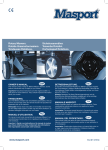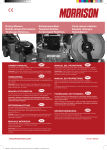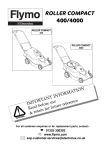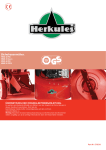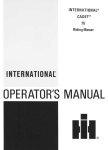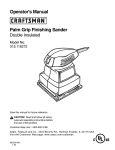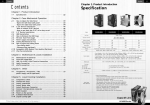Download Masport ROTARY MOWER Owner`s manual
Transcript
Rotary Mowers
OWNER’S
MANUAL
1
IMPORTANT: Keep these instructions and the engine booklet in a safe place for future reference.
They contain important information about your mower.
583152 - Masport Lawnmower Owner’s Manual - May ‘14
Part No: 583152
This manual covers a range of different Masport mowers.
Some features mentioned may not apply to your mower.
PANTONE 648C
2
583152 - Masport Lawnmower Owner’s Manual - May ‘14
EXPLANATION OF
SYMBOLS
1.
2.
3.
4.
5.
6.
7.
8.
9.
75
10.
11.
1.
2.
3.
4.
5.
6.
7.
8.
9.
10.
11.
Read Owner’s Manual
Keep bystander away.
Drive Clutch
Caution rotating blade— keep hands and feet clear.
Remove Spark Plug.
Variable Speed Drive Control
Noise Limit
Wear ear protection
Wear eye protection
Wear protective gloves
Keep bystanders away
Head Office - New Zealand
Head Office - Australia
1-37 Mt Wellington Highway. Panmure,
P.O. Box 14 349
Auckland 1741.
1/40 Abbots Road, Dandenong South,
Melbourne,
Victoria 3175
Revised May 2014
3
583152 - Masport Lawnmower Owner’s Manual - May ‘14
CONTENTS
EXPLANATION OF SYMBOLS
3
SAFETY INSTRUCTIONS
4
ASSEMBLING THE MOWER
5
PREPARING THE ENGINE
5
RUNNING THE ENGINE
6
STARTING6
STOPPING7
DRIVE CONTROLS7
THE GRASS CATCHER
7
MOWING ADVICE9
THE MULCHING BLOCK
10
FITTING THE SIDE DISCHARGE
CHUTE10
CHIPPER MOWERS
10
AFTER MOWING10
BLADES11
MAINTENANCE11
TROUBLE SHOOTING
12
THIS MANUAL COVERS A RANGE OF DIFFERENT MASPORT MOWERS. SOME FEATURES MENTIONED MAY NOT APPLY TO
YOUR MOWER.
IMPORTANT: Keep these instructions and the
engine booklet in a safe place for future reference. They contain important information about
your mower.
Record the serial number, you may need this
when ordering ordering spare parts.
SAFETY
INSTRUCTIONS
6 Stop the engine when crossing gravel drives,
walks or roads.
PLEASE READ ALL INSTRUCTIONS
BEFORE ATTEMPTING TO USE YOUR
MOWER.
8. After striking a foreign object, stop the engine,
remove the wire from the spark plug, thoroughly
inspect the mower for any damage, and repair
the damage before restarting and operating the
mower.
TRAINING
1. Read the operating and maintenance manuals carefully. Be thoroughly familiar with the
controls and the proper use of the equipment.
Know how to stop the mower and disengage the
controls quickly in an emergency.
2. Never allow children or people unfamiliar with
these instructions to operate the mower.
3. Keep the area of operation clear of all persons, particularly small children and pets.
4. Never mow while people, especially children,
or pets are nearby;
5. Keep in mind that the operator or user is
responsible for accidents or hazards occuring to
other people or property.
PREPARATION
1. Thoroughly inspect the area where the equipment is to be used and remove all stones, sticks,
wires, bones and other foreign objects before
mowing, they could be thrown by the blade.
2. Do not operate the equipment when barefoot
or wearing open sandals. Always wear substantial footwear and long trousers. It is advisable to
wear suitable eye protection.
Serial Number
3. Check the fuel before starting the engine. Do
not smoke while fuelling the engine. Do not fill
the fuel tank indoors, never remove the fuel cap
off the fuel tank or add fuel when the engine
is running or until it has been allowed to cool
for several minutes after running. Clean off any
spilled fuel before starting the engine.
4. Never attempt to make a wheel height adjustment while the engine is running.
5. Mow only in daylight, and always keep children away from the mowing area.
6. Never operate the equipment in wet grass.
Always be sure of your footing; keep a firm hold
on the handle and walk; never run. Never walk
backwards while cutting grass.
7. Replace faulty silencers
8. Before using, always visually inspect to see
that the blades, blade bolts, and cutter assembly are not worn or damaged. Replace worn or
damaged blades and bolts in sets to preserve
balance.
OPERATION
1. Disengage all blade and drive controls before
starting the engine.
2. Do not tilt the mower when starting the
engine.
3. Start the engine carefully with feet well away
from the blades.
4. Do not put hands or feet near or under rotating parts. Always keep clear of the blade and
discharge opening.
5. Do not change the engine governor settings
or over-speed the engine. Excessive speed is
dangerous and shortens mower life.
4
583152 - Masport Lawnmower Owner’s Manual - May ‘14
7. Don’t mow over heavy or solid objects as
striking them with the blade can cause serious
damage to the engine and will void your warranty.
9. If the mower should start to vibrate abnormally, stop the engine, disconnect the spark
plug wire, and check immediately for the cause.
Vibration is generally a warning of trouble.
10. Stop the engine whenever you leave the
mower, even for a moment, before cleaning the
mower housing, and when making any repairs
or inspections.
11. When cleaning, repairing or inspecting,
make certain the blade and all moving parts
have stopped and that the engine has had time
to cool. Disconnect the spark plug wire, and
keep the wire away from the plug to prevent accidental starting.
12. Do not run the engine indoors. Lethal exhaust gases can be produced.
13. Shut the engine off and wait until the blade
comes to a complete stop before removing the
grass catcher or unclogging the chute.
14. Mow across the face of slopes; never up and
down. Exercise extreme caution when changing
direction on slopes. Do not mow excessively
steep slopes.
15. Never operate the mower without proper
guards, deflectors provided by the manufacturer,
or other safety devices in place.
16. Never pick up or carry a mower when it is
operating.
17. Where a fuel tap is fitted, turn it off at the
conclusion of mowing and reduce the throttle
setting during runout.
18. Do not operate the engine in a confined
space where dangerous carbon monoxide
fumes can collect.
19. Walk, never run
20. Use extreme caution when reversing or pulling the mower toward you.
21. Stop the baldes if the lawmower has to be
tilted for transportation when crossing surfaces
other than grass, and when transporting the
lawnmower to and from the area to be mowed.
22. Do not start the engine when standing in
front of the dischardge chute.
MAINTENANCE
1. Before using, check the blade(s) and blade
bolt(s) for wear and damage. Replace worn or
damaged blades and bolts in sets to preserve
the balance. DAMAGED BLADES AND WORN
BOLTS ARE MAJOR HAZARDS.
2. Keep all nuts, bolts and screws tight to be
sure the mower is in safe working condition.
3. Never store the mower with fuel in the tank inside a building where fumes may reach an open
flame or spark. Allow the engine to cool before
storing in any enclosure.
4. Store fuel in an approved container safely out
of the reach of children in a cool, well ventilated
place.
5. To reduce fire hazard, keep the engine free of
grass, leaves, or excessive grease.
6. Check the catcher bag frequently for deterioration and wear, and replace worn bags. Check
that replacement bags comply with the original
manufacturer’s recommendations or specifications.
STORING THE MOWER
The handle can be folded to minimise space
requirements.
ASSEMBLING THE
MOWER
Please refer to the following sections when
preparing the mower for its first use.
•
Fitting the handle
•
Preparing the Engine
•
Assembling the catcher
FOLDING THE HANDLE. Loosen the clamp
knobs or unlock the handle lever(s) in the middle
of the handle and fold the top section over the
engine.
NOTE - The left and right sides of the mower are
referred to as viewed from the operating position
behind the handle.
Ergoshift models can also be stored by moving
the handle to the upright position.
FITTING THE HANDLE
In some cases the handle may be completely
detached from the mower body although the
upper handle may be connected by the throttle
control cable. Carefully remove the mower and
handles from the box together to avoid damaging the throttle control.
Assembling the ‘Cam Lock’ Handle.
Most of these models are fully assembled when
packed, so all that is needed is to remove them
from the carton, swing the handle to the operating position and lock the handle lever(s).
The camlock handles on some mowers are
reversed for shipping. To turn them around
unwind the nut to the end of the thread with
a 13mmA/F spanner/socket, pull the camlock
handle outwards and rotate it 180o. Retighten
the nut until the handle locks firmly in place and
it does not change position when in use.
Assembling the ‘Screw Lock’ Handle.
The lower handle is fitted to the mower using
the four bolts located in the handle brackets,
two on each side, ‘A’ in the drawing below. To
bolt the lower handle to the mower fit the bolts
through the lower handle then fit the handle
to the mower body and tighten the nuts on the
outside of the mounting brackets using a 13mm
A/F socket or spanner.
Locked position
when Shipped.
The correct locked
position after refitting.
THE ‘ERGO’ HANDLE
ADJUST
HEIGHT
CAUTION
Check that the control cables are not being
strained while folding and unfolding the
handle. Permanent kinks will make the
controls difficult to operate.
TIPPING THE MOWER SAFELY FOR STORAGE OR INSPECTION.
CAUTION
Tilting the mower—Drain fuel, then tilt the
mower with the spark plug uppermost.
Remove the spark plug lead.
Now attach the upper handle to the lower
handle.
CAUTION
Take care not to rotate the handle before fitting
it, as this will tangle the control cable(s).
Fit the two long bolts through the holes in the
lower handle from the inside with the round
heads snug against the tube. Fit the holes in the
upper handle over the two long bolts. Make sure
that the throttle control is located on the right
hand side. Attach the plastic knob to the outside
of the lower handle bolt as shown below and
tighten by hand until the upper handle is locked
in position.
CAM LOCK
LEVER
The ‘Ergo’ handle can be adjusted to your
preferred height. Simply release both cam lock
levers, move the upper handle to the height
required and re-clamp the cam locks. Where the
mower has screw type locks, wind the knobs
firmly clockwise to lock the handle.
Ergo Shift
Some handles can be rotated forward to give
easy access to the rear flap. Depress the foot
lever u and push the handle until you feel resistance— in a near vertical position v. The handle
can be moved back to the mowing position
without using the foot lever.
5
583152 - Masport Lawnmower Owner’s Manual - May ‘14
PREPARING THE ENGINE
ENGINE CONTROL
This is mounted at the top of the handle. It
operates the choke, if fitted (for cold starting)
and allows you to set the governed speed of the
engine.
PLEASE READ AND UNDERSTAND THE
ENGINE MANUFACTURERS ENGINE
OWNERS MANUAL PRIOR TO OPERATING
THE LAWNMOWER.
WARNING
PETROL VAPOUR IS HIGHLY FLAMMABLE
AND EXPLOSIVE. HANDLE WITH EXTREME
CARE. STORE IN AN APPROVED CONTAINER. DO NOT FILL TANK WHEN ENGINE IS
RUNNING OR IS STILL HOT. DO NOT ALLOW
OPEN FLAME, MATCHES OR SMOKING
NEARBY. FILL TANK OUTDOORS IN A WELL
VENTILATED AREA. WIPE AWAY ANY SPILLS
AND MOVE THE MOWER AWAY FROM ANY
PETROL FUMES BEFORE STARTING
ENGINE.
CAUTION
DO NOT START your four stroke engine
before making sure that it has been filled
with the right amount of the correct grade
of oil. See engine instruction book for
details.
TWO STROKE ENGINES require no special
attention to lubrication provided that the fuel/oil
mixture is correct at all times.
OIL
Four stroke (cycle) engines are shipped without
oil. Place the mower on a level position, unscrew
the ‘OIL FILL’ cap and slowly pour oil into the
sump. Fill to the full mark on the dipstick. Use
SAE 30 engine oil. When checking the oil level,
and before running the engine, screw the dipstick firmly in place.
RUNNING THE ENGINE
FUEL
CAUTION
If a blue plug is fitted beneath the petrol filler cap
it must be discarded. It is for transportation purposes only.
•
For two stroke engines fuel ratio, refer
to engine instruction book.
When filling the fuel tank, always leave an air
space of about 5mm to allow for expansion of
the fuel.
Checking the oil level if the engine is not fitted
with a dip stick.
CHANGING THE ENGINE OIL
FOUR STROKE ENGINES should be checked
for oil level every 8 hours running (or daily), and
the oil should be drained and replaced after
every 50 hours of use.
On all models push control
forward for full throttle.
You will not need to change the control setting
constantly while mowing because the governor
holds the selected speed, even under varying
cutting loads. The positions for CHOKE (cold
start), FAST, SLOW and STOP are usually
marked. If STOP is not marked, move the lever
beyond SLOW to stop the engine.
Some controls have symbols instead of words.
On these,
means CHOKE,
means FAST,
means SLOW,
means STOP.
If your engine control does not have the word
CHOKE or the choke symbol
you have a
Pulsa Prime engine. (See RUNNING THE
ENGINE, MANUAL START MODELS
ENGINE CONTROL. This MUST be correctly
adjusted for easy starting and safe stopping.
If you have cold starting problems, adjust the
outer sleeve of the control cable under the
clamp on the engine at the lower end of the
cable. See engine instruction booklet for details.
Make any adjustments only with the handle in its
normal operating position. After adjusting, check
that the choke butterfly fully closes at one end of
the control lever travel, and that the ignition stop
switch is activated at the other.
ENGINE
Regular attention to a few simple items will
ensure long and trouble-free service from your
mower. Carry out the regular maintenance
described in the engine manual, and check the
engine mounting bolts regularly to be sure they
are tight.
NOTE: THE ENGINE IS WARRANTED BY THE
ENGINE MANUFACTURER AND NOT
MASPORT. YOUR SPECIALIST MASPORT
SERVICE DEALER CAN ASSIST WITH
ENGINE RELATED WARRANTY MATTERS.
STARTING
WARNING
Before making any adjustments to your mower
make sure that the engine is turned off and that
the blade has STOPPED ROTATING. Always
disconnect the spark plug wire and make sure it
cannot accidentally contact the spark plug before
touching anything under the mower housing.
6
583152 - Masport Lawnmower Owner’s Manual - May ‘14
Ensure that the engine has been prepared correctly (see above) and that the fuel tap (if fitted)
is turned ON. We recommend that you check
the oil level before every mowing session.
DRIVE CONTROLS
To engage the mower drive, simply push forward
on the SP bail arm until it meets the handle grip.
Releasing the pressure on the bail will de-clutch
the drive mechanism. Naturally you may use the
mower as a push model by gripping the handle
in the normal way.
MANUAL START MODELS. If the engine
has not been running recently, set the engine
control to the CHOKE position. For Pulsa Prime
engines (which have no CHOKE marking or
symbol on the control), push the primer bulb
on the side of the engine by the carburettor,
refer engine owner’s manual. (Do this also if
you have just refilled the tank after running out
of fuel). Grasp the starter grip, pull slowly until
a resistance is felt and then pull forcefully to
prevent kick-back. Repeat until the engine starts.
Do not pull the cord with a jerk or release it until
fully rewound.—When the engine starts and has
warmed up for a short time, move the control to
the desired speed. Should the engine not start
due to ‘flooding’, move the control to SLOW and
pull the starter six times to clear the flooding.
4.
Confirm that the adjustment is correct by
re-testing the engagement point.
5.
Repeat this adjustment after 150 hours use
of the mower or at any time if the mower
drive seems to be slipping.
IMPORTANT: An incorrectly adjusted clutch
cable, or using the mower with the SP bail not
fully against the handle will cause clutch slippage, gearbox overheating and serious gearbox
damage.
CAUTION
Adjust only to provide positive drive. Excess
pressure will cause cable and belt stretch.
VARIABLE SPEED MODELS
SP DRIVE CLUTCH CABLE ADJUSTMENT
1.
ELECTRIC START MODELS.
Please refer to the Electric Start instructions
supplied with your mower.
Confirm that the cable inner wire will move
at least 26 mm when the SP bail is moved
from the clutch disengaged (open- Fig1and
2) position to the engaged (closed-Fig3)
position against the handle. The first 13mm
moves the lever of the gearbox(Fig4) to
the engaged position and the final 13mm
gives the spring the desired 140N for the
required tension on the gearbox cones to
work properly without slipping under load.
Adjust the contour of the bail slightly if
necessary to achieve this wire stroke.
Some models have an extra control mounted at
the side of the handle to allow the travel speed
of the mower to be varied without changing the
engine speed. This control moves into an one
of eight positions. Move the lever forward to
increase travel speed and backward to lower it.
THIS LEVER SHOULD BE MOVED ONLY
WHILE THE ENGINE IS RUNNING.
[If it is inadvertently moved back when the engine is stationary the drive belt will slacken and
slip. To regain traction, move the lever forward
with the drive disengaged and the engine running.]
Speed changes can be made whether the
mower is moving or not.
THE GRASS CATCHER
HINTS FOR EASY STARTING
1. Stand the mower on a paved drive or
path where the blade is clear of the
grass. If you must start on the lawn, move
to an already cut area and/or raise the
cutting height. Do not start the mower on
a gravel surface.
2. Start a warm engine with the control in
the SLOW position.
3. Keep the mower clean underneath.
2.
HARD STARTING CHECK LIST
Look for these faults:FUEL 1. Insufficient fuel in tank.
2. Fuel tap shut off.
3. Stale fuel.
4. Water or dirt in fuel.
5. Blocked air vent in fuel tank cap.
Wheel the mower backwards toward you
while gradually closing the SP bail, and
note the position of the bail when extra resistance to backward movement indicates
that the drive clutch is just engaging. This
extra resistance should occur when the SP
bail is half way between open and closed
(Fig 5).
IGNITION1. Loose spark plug wire.
2. Dirty spark plug electrodes.
3. Incorrect spark plug gap.
4.Incorrect spark plug type.
OTHER 1. Choked air filter (Dirt or oil).
2. Engine control cable
mis-adjusted.
3. Cutting blade obstructed.
STOPPING
Move the engine control to stop
Fig 5
3.
Fig 6
If the engagement point is incorrect,
adjust it by rotating the thumb-wheel on
the anchor block at the top of the cable
outer sleeve. Rotating the wheel clockwise
will move the clutch engagement point
nearer to the bail closed position, and anticlockwise will move it toward the bail open
position (Fig 6).
CATCHER ASSEMBLY
There are three catcher types:
A.
B.
C.
Bag Catcher
Moulded Plastic Catcher
Aero Catcher (moulded plastic top sections
with fabric side panels.)
A. BAG CATCHER
1. Slide the bag over the wire frame. Fit the
plastic clip up under the frame crossmember (the one which is formed into a handle)
and hook the clip onto the wire crossmember. You may need a lever such as a
screwdriver to open one end of the clip to
get it started over the wire.
7
583152 - Masport Lawnmower Owner’s Manual - May ‘14
2.
3.
Pass the side and front clips inside the
frame and hook them onto the wire in a
similar way.
Fasten the metal front lip to the catcher
assembly by bolting it to the plate on the
bottom of the frame. The bottom panel of
the catcher should be fitted between the
plate and the lip as shown. Fit the screws
from the top with the nuts under the lip, and
tighten them securely.
5.
If your catcher has these parts already assembled, start at step 4.
1. Place the top of the catcher shell (A) on a
firm level surface with its mesh upwards.
2. Holding the top cover (B) with its concave
side facing the mesh, lift its rear end and
engage the front clips with the hooks
on the catcher top shell. Keeping them
engaged, swing the rear of the cover downwards and press it down until the barbs on
the cover engage with the slots in the shell.
7.
over the top shell, carefully aligning the two
parts and ensuring the barbed clips are
aligned with their corresponding slots and
squeeze the rear handles together.
Keeping the catcher upside down, move
the assembly so the lip and rear handle is
supported by the edge of the bench (see
diagram) and catcher is trapped between
your body and the bench.
Strike the top of the assembly with an open
hand above the part supported by the
bench. You should hear the barb click into
place in its slot - if not, check the alignment
and strike again with a little more force.
8.
4
1
10
4.
Turn the assembly over to confirm that the
barbs on the handle are fully home, and
push the tabs on the shell back into position to retain the handle.
Place the top shell on a solid work bench,
open side up. Don’t use a table which may
be damaged by scratching.
8
583152 - Masport Lawnmower Owner’s Manual - May ‘14
THE CATCHER SHOULD BE FITTED TO AND
REMOVED FROM THE MOWER ONLY WHEN
THE ENGINE HAS STOPPED.
Standing to the right of the mower, reach down
with your right hand and pull back and up on the
handle of the safety flap or Smart Chute and
lift it until it is parallel with the handle. Pick up
the catcher with your left hand and swing it into
position at the rear of the mower.
The catcher lip of the fabric and plastic catchers
fits on top of the crossbar or the base of the tunnel, while the two hooks at the top of the Aero
catcher mouth sit on top of the brackets inside
the discharge outlet of the mower. The Series 18
Rotarola catcher has two lugs which fit on the
hooks near the handle brackets of the mower.
Once the catcher is positioned correctly, lower
the flap or Smart Chute to hold it in place. Make
sure that the rear edge of the flap or Smart
Chute is fully engaged on the lip or bar at the
rear of the catcher mouth.
2
7
63
WARNING
‘A’
‘F’
‘F’
WARNING
Working from left to right, and starting by
the rear handle, move around the catcher,
supporting each fastener in turn on the
edge of the bench, as it is pushed into
engagement.
‘B’
Look for the “F” on the handle and ensure
that it will be adjacent to the “F” on the
catcher shell. Fit the handle by pressing
it firmly into the square recesses in the
catcher top.
FITTING THE CATCHER
REMOVING THE GRASS CATCHER
5
9 8
3.
or flap to drop into the lockedposition on the
catcher.
For all types of catcher, make sure that rear edge
of the chute of flap is fully engaged with the
catcher to hold it in place securely.
6.
B. MOULDED PLASTIC CATCHER
There are two types. One has the top cover
and handle already fitted to the top shell of the
catcher, while the other requires these parts to
be assembled.
Position the bottom shell, upside down,
9.
C.
Finally inspect carefully to ensure that all
clips are fully engaged.
AERO CATCHER
The bag and moulded plastic catchers have lips
at the front which fit the top of the crossbar on
the base of the discharge tunnel, while the Series
18 Rotarola catcher has two lugs that fit into the
hooks of the handle brackets.
Aero catchers have two plates under the front
crossbar which hook into the support channel
at the rear of the mower near the ground. Keep
the rear of the Aero catcher near the ground until
the plates are engages with teh support channel,
then pivot the catcher up into position. The chute
or flap can be release as it swings up since the
hooks on the front of the catcher will automatically engage on the mower, allowing the chute
ALWAYS WAIT UNTIL THE ENGINE AND
BLADE HAVE STOPPED COMPLETELY
BEFORE REMOVING THE CATCHER OR
ADJUSTING THE MOWER. REMEMBER, THE
MUFFLER AND NEARBY AREAS MAY BE
VERY HOT.
—All models
Stop the engine and stand to the right of the
mower. Grasp the catcher handle with the left
hand and lift slightly while raising the safety
flap or smart chute with the right hand. Lift the
catcher clear and lower the flap or Smart Chute
to cover the grass discharge outlet.
WARNING
Before clearing away any grass which may have
lodged in the grass chute, ALWAYS STOP THE
ENGINE, make sure the blade has stopped
rotating, AND REMOVE THE SPARK PLUG
WIRE.
CUT HEIGHT CONTROL
The single point cut height control adjusts all
four wheels simultaneously. To operate, steady
the mower by grasping the handle with one
hand, pull the lever outwards from the mower
with the other hand, and move it to the desired
setting.
AVOID USING THE LOWEST
TWO OR THREE CUT SETTINGS IN WET OR VERY
LONG GRASS .
EMPTYING
Dump the grass from the catcher by holding it
vertical, using the rear handle of the moulded
catcher or holding the rear end of the steel
frame of the fabric catcher. Shake if necessary
to dislodge a full load.
CATCHER LEVEL INDICATOR
Some grass catcher models have a Catcher
Level Indicator to show how much grass has
been collected. The indicator functions only
when the engine is running at grass cutting
speed. When the catcher is empty, the indicator
will show all green, nut as the grass progressively builds in height, a red indicator zone
will appear and increase in size. Attempting to
over-fill the catcher will result in discharge chute
blockage or a “dribble” of grass from the front of
the catcher.
Experience in your particular grass and cutting
conditions will soon show the size of the red
indicator area corresponding to the ideal catcher
emptying point, Hose the catcher thoroughly
after each use to keep the indicator movement
free.
As you turn the mower at the end of a strip you
may notice unmulched grass. The mower deck
is naturally tilted upward when turning so that
the air flow which holds the grass in position for
recutting is momentarily decreased. After mowing the lawn, you can go back and mow only the
turns so that the clippings are no longer visible.
MOWING ACCESSORIES
A grass deflector chute for mowing without a
catcher is available for some models from your
dealer. Not required for ‘Smart Chute’ models.
MOWING ADVICE
The best time time to mow your lawn is the
early afternoon. By this time the grass has had
a chance to dry out. Also the sensitive newly cut
grass area isn’t exposed to the direct sun.
For healthy growth, grass should not be cut too
short. Using the lowest settings can result in
destruction of the crown of grass, allowing flat
lying weeds to develop.
Vary your cutting pattern from week to week.
One week mow your lawn from north to south,
the next week, mow your lawn from east to west.
This will help prevent matting and graining of the
grass.
GRASS CATCHER MAINTENANCE
FABRIC TYPES. These depend on a free flow of
air thought the fabric for effective grass collection. Wash as needed to restore and open mesh
in the fabric. Do not leave a fabric bag in direct
sunlight when not in use. While the bag will not
rot if stored wet, prolonged sunlight exposure
can cause premature breakdown of the material. Do not leave clippings in the catcher for
extended periods.
For best performance, always keep the mowers blade sharp. A dull blade tends to tear, not
cut, the blades of grass. When cutting very
long grass, a preliminary cut on a high setting,
followed by a lower cut (preferably a day or so
later), will minimise the overall time required for
the job.
Do not try to cut too much off the grass at one
time. This can cause excessive loads to be
put on the engine and also effect the mulching
performance.
WARNING
CHECK THE CATCHER BAG FREQUENTLY
FOR DETERIORATION AND WEAR, AND
REPLACE IF WORN. Use only genuine original
equipment replacement catcher bags as others
could be dangerous.
MOULDED PLASTIC TYPE. These also need a
free passage of air for efficient catching. Keep
the air outlet mesh clear by hosing it frequently.
Do not leave clippings in the catcher.
Avoid using the lowest two or three height
settings when mulching. For best results when
mulching; cut off only the top third (or less) of
the grass. Cutting lower than this will have a
detrimental effect on the mulching performance.
Clean the mowing chamber frequently to
remove grass build-up. This will keep mowing
performance at its best, especially when mulching. Avoid cutting your lawn when it is wet. Wet
grass tends to form clumps and interferes with
the mulching action of the mower.
If you are not collecting the cut grass, mow in a
pattern that deposits the clippings on the previously cut swathe. So, if your mower discharges
clippings on the left, the next cut should be to
the right of the previous one, and vice-versa.
If you use the mower often without collecting the
clippings, you will find that the accessory grass
delivery chute (available from your Dealer for
most models) will assist by spreading the clippings more effectively.
WARNING
DISCHARGE OPENINGS MUST BE GUARDED
AT ALL TIMES. DO NOT REMOVE THE
GRASS DEFLECTOR OR HOLD THE SAFETY
FLAP UP WHILE MOWING.
When cutting close to obstructions such as tree
trunks, and when mowing to the edge of a lawn
where there is no wheel support, use the left
side of the mower, giving a useful blade ‘overhang’ for ready access to awkward areas.
MOWING ADVICE—‘Smart Chute’
The ‘Smart Chute’ allows you to mow without
catching the grass or mulching. By simply opening the ‘door’ located on the bottom left hand
corner of the ‘Smart Chute’, the lawn can safely
be mown while smoothly spreading the clippings
to the left. For wet, heavy or very long grass we
advise not using the lowest two of three cutting
heights as this may cause clogging. If is still
persists, try walking slower, cutting a narrower
strip or raising the cut height more.
9
583152 - Masport Lawnmower Owner’s Manual - May ‘14
CHIPPER MOWERS
SMART CHUTE
OPEN
When using the chipper tube place the mower
on a level area where markings by he rotating chippings won’t matter. Before starting the
mower fit the catcher and set the cut height to
its lowest setting. Check that the chipper feed
tube is clear and the feed intake flap is in good
order.
WARNING
Check frequently that the blade is sharp and the
retaining screws are tight.
SMART CHUTE CLOSED
ON CATCHER
WARNING
Never use the ‘Smart Chute’ on the catcher with
its door open. This could cause damage or injury
to property or bystanders.
FITTING THE MULCHING
BLOCK TO THE MOWER
1.
Stop the engine
2.
Make sure the discharge chute and the
underside of the mower are clean.See
AFTER MOWING.
3.
Raise the flap, and using the hand hold
on the mulching block, insert the mulching
block, the angled section to the mowers
right, into the discharge chute.
In the case of “open-back” mowers, make sure
that the back of the block is sitting on the rear
axle before lowering the flap. When fitting the
block into a mower with a grass discharge chute,
ensure that the lug at the left side of its base
is slipped into the notch at the bottom rear of
the chute sidewall before lowering the flap. See
‘Mowing Advice’ for mulching tips.
FITTING THE SIDE
DISCHARGE CHUTE
For mowers equipped with a side discharge,
the discharge openings must be guarded at
all times. THE MOWER MUST NEVER BE
OPERATED WITHOUT EITHER THE GRASS
CHUTE OR THE CHUTE FLAP INSTALLED.
Slowly feed material into the intake tube. Sturdy
gloves, footwear, ear and eye protection should
be worn. Empty the catcher frequently to avoid
building up chippings inside the mower housing.
Clear debris away from around the engine frequently to prevent any restriction with cooling air
flow and prevent the risk of fire. Stop the engine
before removing the catcher.
FROM ABOVE
FROM ABOVE
FROM INSIDE
AFTER MOWING
CLEANING
GRASS CHUTE TO BE ATTACHED AS SHOWN.
2 x screws from above with nuts underneath and
1 x screw from inside the housing with nut inside
grass chute.
PERSONAL INJURY, INJURY TO
BYSTANDERS OR DAMAGE TO PROPERTY
COULD RESULT FROM OPERATING A
MACHINE WITHOUT THESE ITEMS FITTED
CORECTLY.
583152 - Masport Lawnmower Owner’s Manual - May ‘14
WARNING
Always stop the engine before attempting to
clear any obstruction from under the mower or in
the chipper tube.
DO NOT REMOVE THE GRASS CHUTE OR
HOLD THE CHUTE FLAP OPEN.
10
Branches up to 35mm can be chipped using
the chipper tube. Only green timber should be
chipped. DO NOT chip hard or dry wood. Hard
and/or dry woods can be place unreasonable
loading on the machine causing damage. Check
that there are no nails or foreign objects in the
material being chipped.
MODELS WITH A CYCLOWASH FITTING.
Stop the engine and remove the catcher. Attach
a garden hose fitting to the cylcowash fitting and
start the engine. Allow a good flow of water to
run for 2-3 minutes. Stop the engine and remove
the hose. Hose the Catcher.
semble in the reverse order.
Cyclowash Fitting
MODELS WITHOUT A CYCLOWASH FITTING.
Stop the engine and remove the catcher. Start
the engine. Keeping well clear of mowing parts,
apply a garden hose to the Wash port with a
good flow of water for 2-3 minutes. Hose the
catcher.
QUICK CUT BLADE/QUADCUT® BLADE.
Follow steps 1 and 2 above. The cutting tips can
be removed and replaced by removing the blade
carrier from the mower. Note the component
positions when dismantling. When refitting the
blade carrier ensure the slots fit properly over
the lugs and the drive plate, and replace the
mounting bolts if they show signs of wear.
MODELS WITHOUT A CYCLOWASH PORT.
Stop the engine, when the blade has stopped,
disconnect the spark plug wire. Remove the
catcher and tip the mower in accordance with
the engine instruction book maintenance section
(spark plug uppermost). Hose the underside of
the mower clean. Hose the catcher.
CAUTION
Quick Cut Blade
DAMAGED BLADES AND WORN BOLTS ARE
MAJOR HAZARDS.
ALWAYS USE GENUINE ORIGINAL EQUIPMENT PARTS TO ENSURE SAFETY AND
PROPER PERFORMANCE. Substitute parts can
be disappointing and dangerous.
BLADE SERVICING INSTRUCTIONS.
BAR AND DISC BLADES.
1.
2.
3.
4.
Remove the spark plug lead and position it
to prevent accidental contact with the spark
plug.
Tilt the mower upright - refer to maintenance section of the engine instruction
book before tilting the mower.
BAR BLADES. Remove the central bolt
and spring washer.
Remove the blade. Either sharpen and
balance the old blade, or fit a new one. As-
45-50 Nm (33-37 ft.lb)
Four 6mm chipper
blade bolts
Four 8mm chipper
blade bolts
Tip mounting bolt
9-11 Nm (6.6-8 ft.lb)
20-22 Nm (15-16 ft.lb)
20-25 Nm (15-18 ft.lb)
ENGINE MAINTENANCE
Consult the engine booklet for the makers
instructions.
DRAINING THE OIL.
While most engines have a drain plug underneath them, it will be found more convenient to
remove the oil dipstick and tip the mower on its
side. Collect the old oil in a suitable tray such as
a two litre ice cream container.
IGNITION.
Your engine has a breaker-less solid state
ignition system which required no maintenance
other than occasional attention to the spark
plug. We recommend cleaning an re-gapping
every 50 hours with replacement every 100
hours (see engine instruction booklet).
DO NOT SANDBLAST PLUGS as abrasive grains can enter the engine and
cause serious damage. USE ONLY THE
EXACT TYPE OF REPLACEMENT PLUG
specified in the engine instruction booklet.
BLADES
CAUTION
Blade center bolt
CAUTION
DO NOT HOSE THE ENGINE, as water can
damage the air cleaner and the ignition system.
REFER TO ENGINE INSTRUCTION BOOK
MAINTENANCE SECTION BEFORE TILTING
MOWER. STORE YOUR MOWER ON ITS
WHEELS, not its side.
Check the blade mounting bolts at frequent
intervals for proper tightness.
Check the blade condition frequently, particularly if the mower has hit a foreign object or is
vibrating. Sub-standard cutting and catching will
result from a neglected blade. Your Authorised
Dealer will be happy to sharpen or replace
blades as necessary, or if you prefer, supply the
parts you will need to do the job yourself.
BLADE REPLACEMENT TORQUE
SETTINGS:-
Quadcut® Blade
CHIPPER BLADE.
1. Follow the servicing instructions for
removing the “Bar and Disc Blades’ on this
page.
2. When the blade carrier is removed from the
crankshaft it can be place in a vice and the
chipper blade removed.
3. Either sharpen and balance out the old
blade, or fit a new one. The mower blade
should also be inspected at the same time.
4. Assemble in the reverse order, taking care
to align the keyway slot in the blade and
the blade driver.
AIR CLEANER.
A clean filter cartridge, correctly fitted, is
ESSENTIAL for long engine life. Service the
filter every 25 hours running (more often under
adverse conditions) according to the instructions
in the engine booklet.
MUFFLER.
A rusted or damaged muffler can permit
increased exhaust noise. Check the muffler
condition periodically and replace it only with a
genuine original equipment part.
DRIVE MAINTENANCE
ROTAROLA.
Every 25 hours Remove the outer chain cover and apply grease
to the chain.
Every 100 hours Remove the outer chain cover, disconnect the
outer chain at its connecting link, withdraw the
sprocket at the top end of the inner chain cover.
Remove the inner chain cover and apply grease
to the chain.
11
583152 - Masport Lawnmower Owner’s Manual - May ‘14
OTHER SELF PROPELLED MODELS.
Every 100 hours Remove each rear wheel by removing the
hub cap, and undoing the 8mm nyloc nut and
washer retaining the wheel to the axle. Remove
the circlip retaining the pinion, taking care not to
over stretch it, and remove the washer and
pinion. Apply grease to pawl y, pinion bore z,
and wheel gear {. Take care to replace the
pawls exactly ass they were removed, and do
not move pinions to the opposite side of the
mower.
SELF PROPELLED CHIPPER MODELS AND
ROTAROLA
These have a belt tensioning idler pulley. To
adjust this, slacken off the clamp screw or nut
which holds the V shaped idler pulley post and
slide the post along the slot in the body. Retighten the screw or nut when the slack in the
belt has been eliminated.
VARIABLE SPEED MODELS.
DO NOT tip the mower up as described above
for single speed models. Variable speed models
have an adjuster on the cable running down
from the speed control to the drive mechanism.
Alter this adjuster only if the travel of the speed
control lever does not match the full range of
available travel speeds.
The adjuster has three parts, two end fittings
each attached to upper and lower outer cables,
and a central barrel connected to the end fittings
by right and left hand threads. Keeping the end
fittings stationary, rotate the barrel to push the
ends apart to increase travel speed, and to bring
the end fittings together to reduce travel speed.
Using this adjuster will compensate for belt
stretch or wear which may occur.
GEARBOX.
The gearbox on these models is a sealed unit
that requires no maintenance. Just jeep the
outside clean.
BELT ADJUSTMENT
SINGLE SPEED MODELS.
(Except self propelled Chipper models &
Rotarola)
Keeping the spark plug uppermost, tilt the
mower to gain access to the gearbox. Using
two 10mm AF spanners, slacken the screw
which clamps the gearbox anchor bracket to the
mower housing just enough to allow the gearbox
to be rotated about its output shaft. Rotate the
gearbox to take any slack out of the V belt drive
and re-clamp the anchor bracket in tis new
position by tightening the clamp and screw
firmly.
FRONT WHEEL DRIVE MULCHING
MOWERS.
Single speed front wheel drive mulching mowers
require the removal of the front transmission
cover to gain access to the adjustment.
To remove the cover, withdraw four retaining
screws - two from the top and two from underneath (Figure 1).
(Figure 1)
TROUBLE
PROBABLE CAUSE
SOLUTION
Uneven or poor cut.
Blunt blade.
Sharpen blade.
Heavy mulch left on
cut strip.
Cutting height is too low
for the height of the grass
being cut.
Adjust the cutting height to approximately
on third of the length of the grass. Then
work down to the desired height.
Engine not running at full
speed.
Move the throttle to fast.
Underside of the mower’s
deck is clogged with wet
grass clippings.
Hose off the underside of the mower
using they cyclowash hole in the mower
body.
583152 - Masport Lawnmower Owner’s Manual - May ‘14
The belt is adjusted by rotating the gearbox about
its output shaft. First loosen the locking screw
(Figure 2) which clamps the gearbox bracket to
the anchor plate bolted to the top of the mower
deck.
(Figure 2)
Then pull the gearbox pulley forward to tighten
the belt. (Figure 3) Do not apply excessive tension
to the belt.
Retighten the locking screw and refit the transmission cover.
Do not over tighten the retaining screws, particularly the ones under the mower.
(Figure 3)
TROUBLE SHOOTING
12
Lift the front of the cover until it clears the top of
the front bumper bar, and draw the cover forward
until it is clear of the mower.
13
583152 - Masport Lawnmower Owner’s Manual - May ‘14
14
583152 - Masport Lawnmower Owner’s Manual - May ‘14
15
583152 - Masport Lawnmower Owner’s Manual - May ‘14
Head Office - New Zealand
1-37 Mt Wellington Highway. Panmure,
PO Box 14 349
Auckland 1741
Head Office - Australia
1/40 Abbots Road
Dandenong South
Melbourne
Victoria 3175
















